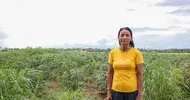International Supermarket News | Thursday, 25 June 2009
Carl Atkin, Head of Research at Bidwells Agribusiness looks at the recent interest in 'strategic food security' and the associated 'land grab' by Middle Eastern Corporations and Governments in countries as diverse of Sudan, Senegal and Sierra Leone.
During the later months of 2008 and the first half of 2009 the broadsheet press has been full of stories about Middle Eastern conglomerates, governments and sovereign wealth funds negotiating land deals in a diverse array of African and Asian countries. But just what is driving this new 'land grab' - and is it good news for African and Asian agriculture, or the next neo-colonialism?
Firstly some background. There is a growing consensus that a structural change has occurred in agricultural commodity markets brought about a combination of strong 'pull' factors - population growth, dietary shift, a changing policy landscape and bioenergy demands; together with a number of so-called 'supply constraints' (land, water and technology). The 'food crisis' of 2007/08 has accelerated the embryonic plans of many countries (in both the developed and developing world) to consider the issue of strategic food supply, with the topic of food security being debated as hotly in the corridors of power in London and Washington DC as in Riyadh and Manama. The desire for a strategic food supply policy is not only driven by an increased concern about being held to the whim of volatile world markets for a substantial proportion of the nation's food supply but also the increased realisation that, in many countries, using increasingly valuable and scarce water supplies to produce agricultural commodities in areas which are already heavily water-stressed is probably not the smartest move, and that importing 'virtual water' embedded in agricultural commodities might be a better bet.
There are opportunities for farming and food supply chain investment on all continents of the globe. Africa has been of particular interest as a result of the eagerness of a number of different governments to offer long leases for a notional (in some cases non-existent) lease payment to foreign investors who promise to bring skills and technology and create employment where the only current activity is small scale smallholder agriculture (or indeed no agriculture at all). If implemented carefully this can be a 'win win' solution - as an external investor can encourage technology and knowledge transfer and create stronger local markets for produce which benefits all agricultural operators. However, engagement at the right levels and in the right way is clearly important and national governments might have little practical jurisdiction over lands controlled by tribal elders. Not understanding local customs and respecting sensitivities will almost certainly mean a project is doomed to failure.
Yet assessment of productivity potential is also only half the story. True, there is a great untapped land resource in many parts of the continent, and with careful and judicious use of irrigation yields of many temperate and tropical crops can be more than doubled from current averages. Conventional theory showing returns from inputs most definitely applies. But lack of infrastructure, disjointed logistics and costs to market are fundamental. These are often underestimated, especially when one considers that tens of thousands of tonnes might need to be bagged into 25 kg sacks and hauled in small trucks to a rather modest port which does not have the facility for any bulk handling of grain. Savings in operational cost can be massively offset by increased logistics and handling costs. Similarly, whilst current ocean freight rates are at rock bottom with the Baltic Dry Index at less than 20% of its peak value, assessment of medium term investment needs to factor in the reality that transport costs (so heavily dependent on energy) will almost certainly rise.
So where is the activity taking place? There is considerable interest in temperate cereal production in the Nile delta of the Sudan and in Ethiopia. Tanzania and Kenya tend to lend themselves to corn and tropical crop production, and the fertile soils of Zambia and Botswana lend themselves to sugar cane and dairying. In short - there is a diverse array of farming systems reflecting local microclimates and agroecology.
Cultural fit is also important. Whilst many in the 'West' perceive Africa to be a high risk investment and might be tempted by the stronger property rights available in say Latin America, for many Middle Eastern and Asian investors there is both a long historical association and increased cultural 'fit' with investment in Africa which means considerably lower risk premiums are attached to such investment propositions.
It has often been said that despite a projected doubling of its population by 2050, Africa could feed itself if it organised its agricultural resources and logistics in an effective way. Not only are there strong moral and humanitarian drivers which suggest the development of agriculture in Africa is fundamental, it offers, for some investors, an exciting investment proposition.












